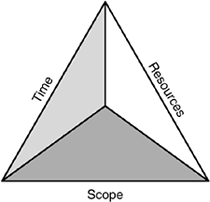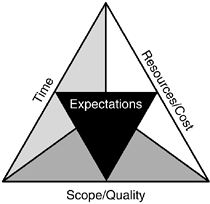Why Are Projects Challenging?
From what we've covered so far, from your own experiences, or from your reading of trade publications, you likely have some appreciation for the difficulty of completing a successful project. While we address many common challenges in more detail throughout this book, let's review the key reasons why projects are challenging to manage:
- Uncharted territory Each project is unique. The work to be done has never been done before by this group of people in this particular environment.
- Multiple expectations Each project has multiple stakeholders that each have their own needs and expectations for the project.

Stakeholder is the term used to describe individuals and organizations who are actively involved in the project, or whose interests may be impacted by the execution or completion of the project.
- Communication obstacles Due to natural organizational boundaries, communication channels, and team development stages, communication of project information must be proactively managed to ensure proper flow.
- Balancing the competing demands Every project is defined to produce one or more deliverables (scope) within a defined time period (time), under an approved budget (cost) with a specified set of resources. In addition, the deliverables must achieve a certain performance level (quality) and meet the approval of the key stakeholders (expectations). Each of these factors can affect the others, as Figure 1.2 and Figure 1.3 illustrate. For example, if additional functionality (scope, quality) is desired, the time and/or cost (resources needed) of the project will increase. This is a key focus of an effective project manager.
Figure 1.2. Competing project demands (traditional model). This figure summarizes the relationships between the natural competing demands of projects.

Figure 1.3. Competing project demands (modern model). This figure summarizes the relationships between the natural competing demands of projects.

- Cutting Edge Often, projects have a strategic, innovative focus. As a result, they will often deal with new, leading edge technologies. In these cases, the project has more risks, more unknowns, and is much more difficult to estimate accurately.
- Organizational Impacts In addition to overcoming natural communication obstacles created by the project structure, the project manager must also manage overlaps in organizational approval and authority domains, contend with competing priorities for shared resources, deal with annual budget cycles that may not be aligned with the project's funding needs, and ensure that the project is aligned with the focus of the organization.
- Collaboration Depending on the strategic level and scope of your project, your project team will consist of stakeholders across the organization from different functional areas that are likely not accustomed to working together. For project success, these different stakeholders must learn to work together and to understand the others' perspectives in order to make the best decisions for the project. Often, the project manager plays a key facilitating role in this collaboration process.
- Estimating the Work Estimating project work is difficult, yet the time and cost dimensions of the project are built upon these work effort estimates. Given the facts that the work of the project is often unique (never been done before at all, never been done with these tools, and/or never been done by these people), and most organizations do not maintain accurate historical records on previous projects (that may have similar work components), it is difficult to accurately estimate the effort for individual work items, not to mention the entire project. For the entire project, you need to anticipate the quantity and severity of the issues and obstacles that are likely to surface. We'll cover this in more detail in Chapters 7, "Estimating the Work," and 14, "Managing Project Risk."
|
The competing project demands are often referred to as the triple constraint of project management. Time and Cost (or Resources) are always two sides of the triangle. Depending on where you look, the third side is either Scope, Performance, or Quality. In either case, it's the "output" of the project. Additionally, many recent variations of this model have included the additional demand of Client Expectations. |
Part i. Project Management Jumpstart
Project Management Overview
- Project Management Overview
- What Is Project Management…Exactly?
- What Is the Value of Project Management?
- Why Are Projects Challenging?
- Growing Demand for Effective Project Managers?
- Trends in Project Management
The Project Manager
- The Project Manager
- One Title, Many Roles
- Key Skills of Project Managers
- Qualities of Successful Project Managers
- 15 Common Mistakes of Project Managers
Essential Elements for any Successful Project
- Essential Elements for any Successful Project
- What Exactly Is a "Successful" Project?
- Learning from Troubled Projects
- Learning from Successful Projects
- Essential Project Manager Toolkit
Part ii. Project Planning
Defining a Project
- Defining a Project
- Setting the Stage for Success
- How Does Defining a Project Relate to Project Planning?
- Project Definition Document
- Project Definition Checklist
Planning a Project
- Planning a Project
- Key Project Planning Principles
- Important Questions Project Planning Should Answer
- Building a Project Plan
- Summary of Supplemental Project Plan Components
- Project Plan Checklist
Developing the Work Breakdown Structure
- Developing the Work Breakdown Structure
- What Is a WBS Exactly?
- Why Is the WBS Important?
- The Process of Building a WBS
Estimating the Work
- Estimating the Work
- Next Step in the Schedule Development Process
- Managing the Risk, Managing the Estimates
- Reasons for Estimating Woes
- Powerful Estimating Techniques and Methods
- Best Practices
Developing the Project Schedule
- Developing the Project Schedule
- The Impact of the Project Schedule
- The Goal of the Schedule Development Process
- Key Inputs for Building a Schedule
- Creating a Schedule
Determining the Project Budget
- Determining the Project Budget
- The Impact of the Project Budget
- Principles of an Effective Budget
- Creating a Project Budget
- Common Budget Challenges
Part iii. Project Control
Controlling a Project
- Controlling a Project
- What Is Project Control?
- Management Fundamentals for Project Control
- Powerful Techniques for Project Control
- Performance Reporting
- Variance Responses
- Leveraging Earned Value Management Concepts
- Common Project Control Challenges
- Lessons from Project Recoveries
Managing Project Changes
- Managing Project Changes
- What Exactly Is a Project Change and Whats the Big Deal Anyway?
- Fundamentals for Managing Project Change
- What Causes Unplanned Scope Changes?
- Essential Elements of a Project Change Control System
- Powerful Techniques for Minimizing Project Changes
- Common Project Change Control Challenges
Managing Project Deliverables
- Managing Project Deliverables
- "Managing Project Deliverables" Means What Exactly?
- Why Do This? Its Too Much Work
- Identify, Protect, and Track: The Principles of Managing Work Products
- Best Practices
- Configuration Management Plan
- Common Challenges and Pitfalls
Managing Project Issues
- Managing Project Issues
- The Goals, Objectives, and Principles of Project Issue Management
- Key Features of Issue Management System
- Options for Issue Log
- Best Practices
- Some Special Situations
Managing Project Risks
- Managing Project Risks
- Key Risk Management Principles
- The Essential Process for Managing Project Risks
- The Common Sources of Project Risk
- Typical Problems
- Powerful Risk Control Strategies
- Are You Sure Its a Risk?
Managing Project Quality
- Managing Project Quality
- What Is "Project Quality"?
- Unique Aspects of Managing Project Quality
- Principles of Managing Project Quality
- Powerful Tools and Techniques for Project Quality
- Powerful Quality Strategies
- Typical Quality-Related Challenges
Part iv. Project Execution
Leading a Project
- Leading a Project
- More Than Managing
- Where Is Leadership Needed on a Project?
- Twelve Keys to Better Project Leadership
- Power of Servant Leadership Approach
Managing Project Communications
- Managing Project Communications
- What Are Project Communications?
- The Importance of Project Communications
- Why Communicating Can Be Tough
- Seven Powerful Principles
- Best Practices of Effective Project Communicators
Managing Expectations
- Managing Expectations
- Value of Reviewing Stakeholder Expectation Management
- Critical Aspects of Expectations
- Seven Master Principles of Expectation Management
- Essential Elements of Managing Expectations
Keys to Better Project Team Performance
- Keys to Better Project Team Performance
- High-Performing Teams
- Ten Key Principles
- Proven Techniques
- Special Situations
Managing Differences
- Managing Differences
- Five Key Principles
- Proven Techniques for Leading Cross-Functional Projects
- Proven Techniques for Leading Cross-Cultural Projects
- Proven Techniques for Leading Virtual Projects
Managing Vendors
- Managing Vendors
- First, Lets Clarify a Few Terms
- Ten Proven Principles of Vendor Management
- Twelve Tips for Buyers
- Seven Tips for Sellers
- Twelve Key Project Management Skills for Better Vendor Management
- Stuff You Need to Know About Contracts
Ending a Project
EAN: N/A
Pages: 169
